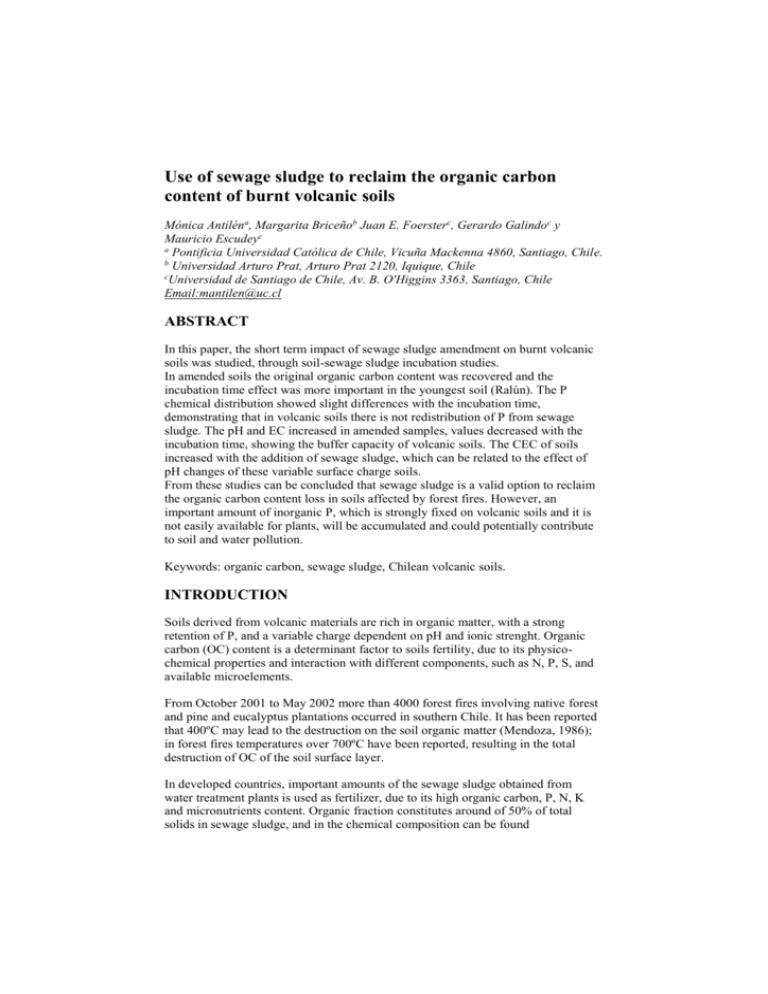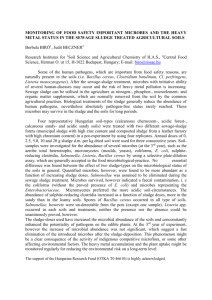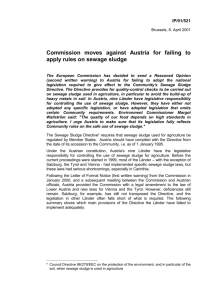Use of sewage sludge to reclaim the organic carbon content of burnt
advertisement

Use of sewage sludge to reclaim the organic carbon content of burnt volcanic soils Mónica Antiléna, Margarita Briceñob Juan E. Foersterc, Gerardo Galindoc y Mauricio Escudeyc a Pontificia Universidad Católica de Chile, Vicuña Mackenna 4860, Santiago, Chile. b Universidad Arturo Prat, Arturo Prat 2120, Iquique, Chile c Universidad de Santiago de Chile, Av. B. O'Higgins 3363, Santiago, Chile Email:mantilen@uc.cl ABSTRACT In this paper, the short term impact of sewage sludge amendment on burnt volcanic soils was studied, through soil-sewage sludge incubation studies. In amended soils the original organic carbon content was recovered and the incubation time effect was more important in the youngest soil (Ralún). The P chemical distribution showed slight differences with the incubation time, demonstrating that in volcanic soils there is not redistribution of P from sewage sludge. The pH and EC increased in amended samples, values decreased with the incubation time, showing the buffer capacity of volcanic soils. The CEC of soils increased with the addition of sewage sludge, which can be related to the effect of pH changes of these variable surface charge soils. From these studies can be concluded that sewage sludge is a valid option to reclaim the organic carbon content loss in soils affected by forest fires. However, an important amount of inorganic P, which is strongly fixed on volcanic soils and it is not easily available for plants, will be accumulated and could potentially contribute to soil and water pollution. Keywords: organic carbon, sewage sludge, Chilean volcanic soils. INTRODUCTION Soils derived from volcanic materials are rich in organic matter, with a strong retention of P, and a variable charge dependent on pH and ionic strenght. Organic carbon (OC) content is a determinant factor to soils fertility, due to its physicochemical properties and interaction with different components, such as N, P, S, and available microelements. From October 2001 to May 2002 more than 4000 forest fires involving native forest and pine and eucalyptus plantations occurred in southern Chile. It has been reported that 400ºC may lead to the destruction on the soil organic matter (Mendoza, 1986); in forest fires temperatures over 700ºC have been reported, resulting in the total destruction of OC of the soil surface layer. In developed countries, important amounts of the sewage sludge obtained from water treatment plants is used as fertilizer, due to its high organic carbon, P, N, K and micronutrients content. Organic fraction constitutes around of 50% of total solids in sewage sludge, and in the chemical composition can be found carbohydrates, fatty acids and proteins (Chang et al, 1981), which are decomposed and assimilated by soil microorganism. For the other side, the sewage sludge needs to be disposed, and it should be considered to ameliorate the OC lost due to forest fires in Chilean soils. The objective of this paper was to reclaim the original organic carbon content of burnt volcanic soils, evaluating the short-term impact through soil-sewage sludge incubation studies. METHODS Soil samples from 0-15 cm depth of Collipulli (Ultisol; Fine, mesic, Xeric, Paleumult), Ralún (Andisol, medial, mesic, Acrudoxic Hapludands) and Diguillín (Andisol; Medial, mesic, Entic Dystrandept) collected from uncultivated areas were used. All samples were air-dried and sieved to 2mm. Municipal sewage sludge was obtained from a water treatment plant from Santiago, located on the Central region of Chile. The sludge was added to each soil in the amount needed to recover the OC lost after heated in a furnace at 200ºC and 400°C (Antilén, 2001). All soils were incubated at room temperature and sampled after two and four months. Four different treatments for each soil were considered: incubated control soil (C); soil burnt at 200ºC (S-1) and 400ºC (S-2), soil burnt at 200ºC (S-3) or 400°C (S-4) with addition of sewage sludge. Samples without time of incubation (0 months) were also considered. Soils, sewage sludge, and samples after the incubation time were characterized for organic carbon content (Walkley-Black method, Sadzawka, 1991), exchangeable bases, cation exchange capacity (CEC, determined as exchangeable bases plus extractable acidity at pH 7.2, Sadzawka, 1991), phosphorus chemical fractionation (Escudey et al., 2004), electric conductivity (EC) and pH (soil water ration 1:2.5). RESULTS Characterization The characterization of samples is presented in Table 1. The sewage sludge has about three times the OC content of soils. The OC content in Andisols (Ralún and Diguillin) is higher than in Ultisol (Collipulli). This accumulation is related with mineralogy dominated by low crystalline compounds. The pH was acidic for all soils, while for sewage sludge the pH was close to neutrality. The CEC of sewage sludge was almost two times higher than soils, due to exchangeable bases values, mainly Ca2+. The EC for sewage sludge was ten times higher than soils, in agreement with the EB values. Table 1. Characterization of soil and sewage sludge sample Sample EB CEC OC (cmol(+)kg-1) (cmol(+)kg-1) (wt%) Collipulli 7.80.5 37.74.0 1.80.0 Ralún 3.00.6 44.85.0 6.90.0 Diguillín 10.33.7 54.24.2 5.80.1 Sewage sludge 87.89.8 105.58.2 18.00.5 EC (mS) 0.10.0 0.20.0 0.20.0 1.90.1 Total P (mg kg-1) 57615 90136 175889 10200358 pH 4.80.1 4.40.1 5.20.2 6.90.2 The total P in the Ultisol is lower than in Andisols, showing the sequence Collipulli<Ralún<Diguillín. In the sewage sludge the total P was about two orders higher than in soils. Incubation studies An important loss of easily oxidable OC occurred between 200ºC (S-1) and 400ºC (S-2) as shown in Table 2. At this temperature range, decarboxylation, dehydrogenation and dehydroxylation process had been described (Galindo et al., 1987). In the burnt control soil no changes were observed after the incubation time. Burnt samples amended with sewage sludge, shown a recuperation of the lost OC content; the incubation time was important only in Ralún soil at 400ºC where as much as twice the easily oxidable OC after four month of incubation time was observed. Thus, from the OC content point of view, sewage sludge can be considered as an alternative to reclaim the original soil OC content. Table 2. Easily oxidable OC content in soils and sewage sludge treated samples after 2 and 4 months of incubation Sample OC wt% 0 months 2 months 4 months Collipulli C 1.80.0 1.80.0 1.80.0 S-1 (200ºC) 1.60.1 1.50.1 1.60.0 S-2 (400ºC) 0.40.0 0.40.0 0.40.0 S-3 (200ºC) 1.80.1 1.70.2 2.00.1 S-4 (400ºC) 1.80.0 2.30.2 2.20.2 Diguillín C 5.80.0 5.80.0 5.80.0 S-1 (200ºC) 5.30.5 5.90.0 5.70.2 S-2 (400ºC) 1.70.2 2.40.2 2.10.1 S-3 (200ºC) 5.80.2 6.30.1 6.10.0 S-4 (400ºC) 5.80.0 6.40.2 6.30.1 Ralún C 6.80.0 6.90.0 6.90.1 S-1 (200ºC) 5.30.1 5.70.1 6.10.0 S-2 (400ºC) 1.00.0 2.30.1 2.00.0 S-3 (200ºC) 6.90.1 6.60.0 7.90.0 S-4 (400ºC) 6.90.0 8.00.3 7.00.3 About 45 to 65% of total P in control soils is present as organic-P, mainly associated to humic acids (Figure 1). Depending of the soil from 4 to 23% at 200ºC and from 26 to 44% at 400ºC of that organic P was turned into in inorganic P. The P chemical fractionation of sewage sludge indicated that only 10% of total P was present as organic P. Around 80% of this organic P is associated to fulvic acids and 20% to humic acids. Then, the amendment with sludge will increase the inorganic P accumulation of this type of soils. In agreement with this statement, the inorganic-P increases in all sewage sludge treated soils. The inorganic-P content in treated samples is related with the total amount of sewage sludge added to each soil (Figure 1). The P forms distribution showed slight differences with the incubation time, demonstrating that P from sewage sludge is not significantly redistributed to more available P-forms in volcanic soils after a short period of time. P e r c e n t ( % ) P e r c e n t ( % ) 1 0 0 ( a ) ( b ) 8 0 6 0 4 0 2 0 0 1 0 0 ( c ) ( d ) 8 0 6 0 4 0 2 0 T r e a t m e n t s S-2( C 0 S-2(m) 2m) S-2( 4 S-4( m) 2 S-4(m) 4m) S-1(0 C S-1(2m) m S-1(4) S-3( m) 2 S-3(m) 4m) 0 I n o r g a n i c P F u l v i c P H u m i c P T r e a t m e n t s Figure 1. P forms distribution in Collipulli (a), (b) and Ralún (c) and (d) soils with different treatments The pH increases in all burnt samples (Table 2), and in sewage sludge treated samples. In general, a decreases with incubation time is observed, showing the buffering capacity of soils. Table 2. Evolution of pH and electrical conductivity in samples with two (2m) and four months (4m) of incubation. Sample pH EC (mS) 2m 4m 2m 4m Collipulli C S-1 S-2 S-3 S-4 5.460.02 6.140.02 6.010.03 6.040.02 6.610.02 5.360.01 5.890.01 5.790.01 5.910.02 6.200.01 0.080.01 0.110.00 0.170.01 0.300.01 1.080.01 0.080.00 0.120.01 0.290.00 0.260.02 1.480.01 Ralún C S-1 S-2 S-3 S-4 4.960.01 5.680.01 6.710.02 5.780.01 6.600.01 5.100.01 5.840.02 5.960.01 5.500.03 6.810.02 0.220.01 0.200.00 0.350.01 0.710.02 2.250.01 0.360.01 0.250.01 0.460.01 0.800.00 1.940.01 Diguillín C S-1 S-2 S-3 S-4 6.020.01 6.590.02 6.470.02 6.360.03 6.940.03 5.840.02 5.970.03 6.580.02 5.770.01 6.810.01 0.240.02 0.200.01 0.430.01 0.490.01 1.940.01 0.250.01 0.530.02 0.730.01 0.880.01 2.010.02 The EC of burnt soils increases with heating temperature and incubation time, due to cations and anions coming from organic carbon combustion (mainly exchangeable bases and carbonate). In all sewage sludge treated soils the EC increases about two times, because of the ionic release of sewage sludge; also incubation time increases the EC as result of a continuous slow delivery of ionic species from sewage sludge, controlled by their solubility constants. The CEC decreases when soil heating temperature increases, the OC destruction not only results in a lost of active sites, but also results in the exposition of inorganic active surface sites as Al-OH and Fe-OH with pKa higher than carboxylic or phenolic groups, and consequently with positive surface charge at the equilibrium pH observed (Galindo et al., 1987). The CEC of soils increases with the addition of sewage sludge, which can be related to the exchangeable bases and the organic matter content increment because of amendment. 7 0 (+) kg -1 ) 6 0 C o llip u lli2 m C o llip u lli4 m R a lú n 2 m R a lú n 4 m 5 0 CEC(cmol 4 0 3 0 2 0 1 0 C S 1 S 2 C S 1 S 2 7 0 (+) kg -1 ) 6 0 5 0 CEC(cmol 4 0 3 0 2 0 1 0 T r e a tm e n t Figure 2. Changes in CEC in burnt and amended Collipulli and Ralún soils in 2 and 4 months. CONCLUSIONS From these experimental data can be concluded that the sewage sludge is a valid option to reclaim the organic carbon lost in soils affected by forest fires. Additionally the sewage sludge produced changes in pH, electric conductivity, CEC and P forms. The pH changes observed with the temperature and with the sewage sludge could be considered appropriate to soils derived from volcanic materials, due to their acidic characteristics which may result in aluminum toxicity problems. The incubation time decreased the pH to initial values of all sewage sludge treated samples, showing the buffer capacity of volcanic soils. The organic-P is turned into inorganic-P with temperature. The inorganic-P significantly increased in amended soils, which is strongly fixed on volcanic soils and it is not easily available for plants. It will be accumulated and could potentially contribute to soil and water pollution. The increment of EC of treated soils will not result in a salinity problem due to the pluviometry in the region where soils are located. The use of sewage sludge increased the total amount of Mg, K, and Zn in soils. ACKNOWLEDGEMENTS This study was supported by DICYT-USACH, FONDECYT (grant 1030778) and DIPUC Nº2003 16/E2. REFERENCES Antilén, M., 2001, Efecto del impacto térmico en suelos: Estudio de la relación temperatura-propiedades del suelo y modelación del gradiente de temperatura en profundidad, Doctoral dissertation, Universidad de Santiago de Chile. Escudey, M., Galindo, G., Avendaño, K., Borchardt, D., Chang, A. and M. Briceño, 2004, Distribution of phosphorus forms in Chilean soils and sewage sludge by chemical fractionation and 31P-NMR, J. Chil. Chem. Soc., 49, 219. Sadzawka, A., 1991, Métodos de Análisis de Suelos, Serie La Platina N°16, INIA, Santiago. Mendoza, O.S., 1986, Efecto de las quemas sobre la fertilidad del suelo en la habilitación de terrenos para la forestación, Tesis de Grado, Universidad de Chile, Santiago, Chile. Chang, A.C., Page, A.L. and F.T. Bingham, 1981, Re-utilization of municipal wastewater sludges-metals and nitrate, J. WPCF, 53, 237. Galindo, G., Castillo, R., and M. Escudey, 1987, Efecto de la temperatura sobre la carga superficial de algunos suelos chilenos derivados de materiales volcánicos. Cien. Invest. Agr. 14,23.








